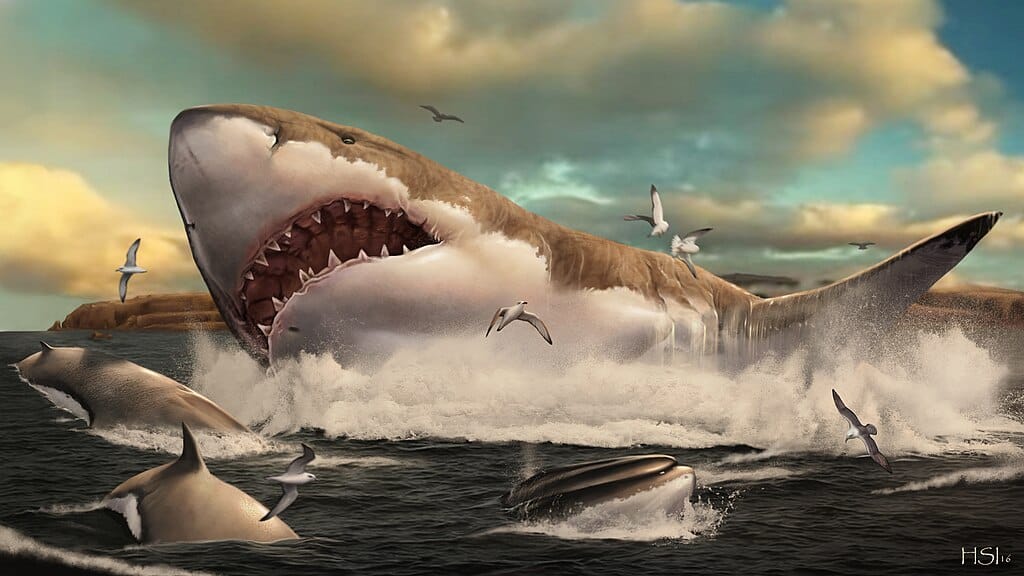The ocean is a place of mystery and wonder, filled with creatures both majestic and terrifying. While the Great White Shark is often considered the apex predator of the seas, there once existed a marine monster that dwarfed even this formidable creature. Welcome to the world of the Megalodon, the ancient sea monster that could swallow a Great White whole.
What is a Megalodon?

The Megalodon, scientifically known as Otodus megalodon, was a massive shark that dominated the world’s oceans millions of years ago. Its name translates to “big tooth,” which is a fitting description considering the size of this prehistoric predator. Megalodon roamed the seas from approximately 23 to 3.6 million years ago during the Cenozoic Era, making it one of the most formidable creatures to have ever lived.
Size and Dimensions of the Megalodon

Estimates suggest that the Megalodon could grow to lengths of up to 60 feet or more, with some even speculating that rare individuals might have reached 80 feet. To put this into perspective, the largest Great White Sharks today usually measure around 20 feet. The sheer size of the Megalodon would allow it to swallow smaller prey, including a Great White, with relative ease.
The Enormous Bite Force

Megalodon possessed a jaw that could exert an incredible amount of force. Studies suggest it had a bite force between 24,000 to 40,000 pounds, the strongest of any known creature. This bite force would have allowed Megalodon to crush the bones of larger prey, including whales and other sizable marine animals, facilitating its dominance in the aquatic food chain.
Diet and Eating Habits

Megalodon’s diet primarily consisted of marine mammals such as dolphins, whales, and seals, with a particular penchant for baleen whales. Fossil evidence indicates that it was a highly adaptable predator, capable of attacking with incredible speed and stealth. Megalodon’s hunting technique likely involved biting off the flippers and tails of its prey to immobilize them before proceeding to feast.
Fossil Evidence and Discoveries

Megalodon fossils have been found worldwide, from the Americas to Europe and Australia, providing essential clues about their lifestyle and ecosystem. The most common fossils are the massive, serrated teeth, which can measure over seven inches. The scarcity of complete skeletons is due to sharks having cartilaginous rather than bony skeletons, which are less likely to fossilize over time.
Megalodon’s Extinction

Megalodon’s extinction remains a subject of scientific investigation, with hypotheses suggesting changes in ocean temperatures, decline in prey availability, and competition from other predators like orcas contributing to its downfall. As the global climate cooled during the Pliocene Epoch, Megalodon—adapted to warm tropical and subtropical environments—found its habitat contracting, leading to its gradual disappearance.
Comparison with Modern-day Sharks

Modern sharks, while impressive, are a mere shadow of Megalodon’s size and prowess. Great Whites, the closest living relatives in terms of ecological role, display similar hunting strategies but operate on a smaller scale. Understanding Megalodon’s size and abilities offers a fascinating glimpse into the evolutionary pressures that shaped today’s apex marine predators.
Legends and Cultural Impact

Throughout history, tales of giant sea monsters have permeated folklore. Though Megalodon had long been extinct by the time humans walked the Earth, discoveries of its giant teeth may have fueled legends and stories about colossal ocean-dwelling beasts, melding fact and myth into the captivating sea lore we hear today.
Role in the Marine Ecosystem

As a top predator, Megalodon played a crucial role in its marine ecosystem by regulating the population of large marine animals. This predator-prey relationship ensured healthy populations and a balanced marine environment, demonstrating the essential role apex predators play in maintaining ecological integrity.
The Ongoing Search for Megalodon

The idea of Megalodon’s survival into modern times has captivated public imagination, but there is scant evidence to support this notion. Scientists continue to study ocean depths, but so far, credible evidence of Megalodon’s current existence remains elusive. Modern searches highlight not only our fascination with ocean mysteries but also the importance of science in demystifying the natural world.
Representation in Popular Culture

Megalodon holds a prominent place in popular culture, with books, movies, and documentaries exploring its terrifying potential. Films like “The Meg” have reignited interest in these ancient giants, mixing scientific facts with fiction to create thrilling narratives that capture the public’s imagination and inspire a fascination with prehistoric life.
Why Study Extinct Giants?

Studying extinct creatures like Megalodon can offer insights into the mechanisms of evolution, the effects of climate change over time, and the intricacies of ancient ecosystems. Understanding such giants can enlighten how current marine animals might adapt to ongoing environmental challenges.
Conclusion

The Megalodon, a true titan of the seas, reminds us of a time when our oceans were dominated by creatures of extraordinary biology and magnitude. While they may be long extinct, their legacy endures through scientific study and popular fascination, inviting us to appreciate the complexity and history of marine life. In contemplating the Megalodon, we gain a deeper understanding of evolution, extinction, and the timeless mysteries of our planet’s oceans.
- How Water Scarcity Could Spark Mass Migration in America - August 9, 2025
- Why Scientists Are Studying Sloth Fur for Medical Research - August 9, 2025
- New Ice Core Samples Could Rewrite Climate History - August 9, 2025

